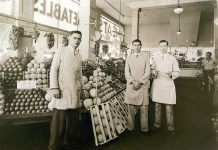Apples dot the trees like a child’s drawing in second grade;
blackberries hang in tantalizing clusters, just out of reach but
not really; peaches are still ripening and some of the heartiest
ones are yet to come — perfect for a pie.
For most folks, pies are something their mothers or grandmothers
baked, or, you buy one at the bakery or from the frozen food
section in the supermarket. This lack of pie-making is a real loss
for humanity, particularly the humanity that still eats at
home.
I defy any commercial bakery to rival a homemade pie. No, I take
that back. I don’t want to arouse any rivalry. I will just state
that in my opinion nobody can make a pie like a homemaker in
his/her own kitchen following a proper recipe, particularly for the
pie crust.
So, for those of you who have never made a pie, here is how it
is done. First of all, buy a pie plate. Purchase, also, some Crisco
vegetable shortening (not the yellow kind) and you must have all
purpose flour, salt and ice water. You’ll need a rolling pin and a
pancake turner and a surface to roll out the dough. A couple of
bowls and some waxed paper must be on hand as well.
Here’s the procedure and the recipe.
For a double crust:
2 and ¼ C. sifted all-purpose flour
1 tsp. Salt
¾ C. shortening (Crisco!)
5 T. ice cold water (use ice cubes to cool the water)
Mix flour and salt in bowl.
With pastry blender or two knives, scissor fashion, cut in
shortening until size of peas.
Sprinkle mixture with 5 T. ice cold water, stirring with fork
until everything is moistened. DO NOT ADD ANY MORE WATER —
EVER!
Turn out dough on generously floured surface and form into a
ball. Flour your hands, the rolling pin and the ball of dough. Cut
in half and roll out the first half. Using the pie plate as a
guide, roll the dough to slightly overlap the plate’s sides.
Fill the pie with fruit filling — this is so easy with all the
fresh, delicious fruit available now — just follow any recipe. All
the fruit pies require some sugar, a little flour, usually some
cinnamon and then dot the contents with about 1 ½ T. cold
butter.
Roll out the top crust and pinch the lower and top together.
Prick the top with a fork in about six places so that the steam can
escape while baking or else your crust will rise like a balloon and
pop.
Before you bake your pie, which you will do at about 425
degrees, you will need to tear three strips of aluminum foil about
three inches wide and the length of the roll, placing the foil
around the dough edges of the pie plate. This will prevent the rim
from over cooking while the rest of the pie bakes. You will remove
the foil after the pie comes out of the oven and before it
cools.
You may also freeze a pie after you have adjusted the top crust.
In this instance you will NOT prick the top crust. Simply cover the
pie with plastic wrap first, followed by another layer of aluminum
foil. Label pie as unbaked and include baking instructions with
date of the pie making.
For clean-up, take the pancake flipper you used to lift the
crust onto the pie plate and scrape any flour off the work surface.
I forgot to instruct you to use the flipper to remove the dough
from the counter top? The dough is in little pieces? It is stuck?
You are stuck in it? Keep dry flour handy and always resort to that
to repair any broken pieces of dough. Keep your hands floured and
the rolling pin floured. When the dough is the correct size, use
the pancake flipper to fold one-half of the dough over the other.
Then, lift the remaining half into the pie dish and return the
folded half back onto the dish.
Don’t be discouraged. Remember your grandmother and you will,
when the aroma of freshly baking pie fills your home, followed by
the simple delight of a forkful of flaky, homemade crust covering
warm, juicy fruit.
Renee Kiff weeds and writes at her family farm in Alexander
Valley.








